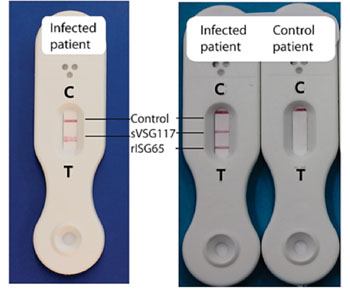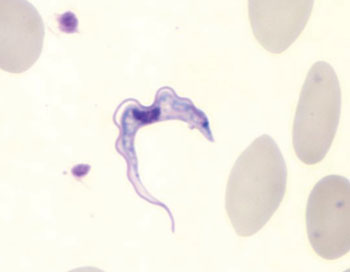Lateral Flow Test Evaluated for African Trypanosomiasis
By LabMedica International staff writers
Posted on 05 Aug 2014
A prototype lateral flow test has been developed to diagnose human African trypanosomiasis, also known as sleeping sickness, which could improve on the Card Agglutination Test for Trypanosomiasis (CATT).Posted on 05 Aug 2014
Human African Trypanosomiasis (HAT) is caused by infection with Trypanosoma brucei gambiense and the diagnosis of this parasitic infection currently relies primarily on a CATT or microscopy, both of which have their limitations, and there is no simple immunodiagnostic test for infection with the other subspecies, T. b. rhodesiense.
Scientists at the University of Dundee (UK) screened pools of infected and control sera against four different soluble form variant surface glycoproteins (sVSGs) by enzyme-linked immunosorbent assay (ELISA). The pooled sera were from 10 stage 1 T. b. gambiense patients, 40 stage 2 T. b. gambiense patients and 50 matched uninfected patient sera. One glycoprotein called sVSG117, showed particularly strong immunoreactivity to pooled infection sera.
The sVSG117 was supplied to an immunoassay development and manufacturing company, BBI Solutions, (Cardiff, UK) to make single and dual antigen lateral flow test (LFT) devices for both blood and serum samples. After the application of the sera, the LFT is examined after 30 minutes, and scoring of the test bands was performed by visual comparison of freshly completed tests with a scoring card. For the virtual field trial, two people scored all of the LFT devices independently. If there was disagreement about the infection-status of a given serum sample, a third individual provided adjudication.
In the virtual field trial, using two positive antigen bands as the criterion for infection, the sVSG117 and rISG65 dual-antigen lateral flow test prototype showed a sensitivity of 97.3% and a specificity of 83.3% for the detection of T. b. gambiense infections. The device was not as good for detecting T. b. rhodesiense infections using two positive antigen bands as the criterion for infection, with a sensitivity of 58.9% and specificity of 97.3%. However, using one or both positive antigen band(s) as the criterion for T. b. rhodesiense infection improved the sensitivity to 83.9% with a specificity of 85.3% These results encourage further development of the dual-antigen device for clinical use.
The authors concluded that LFT technology offers advantages over CATT with respect to the criteria components of the World Health Organization (WHO; Geneva, Switzerland) of affordable, sensitive, specific, user-friendly, rapid, equipment-free and deliverable to the people at need (ASSURED). The ideal second-generation LFT is likely to use two recombinant, rather than native, antigens and recombinant ISG65 and/or VSG domains could be the answer. The study was published on July 17, 2014, in the journal Public Library of Science Neglected Tropical Diseases.
Related Links:
University of Dundee
BBI Solutions
World Health Organization
















